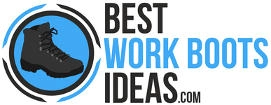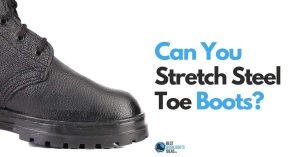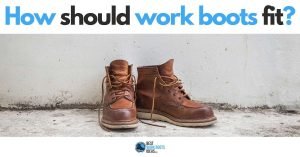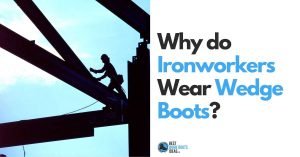What Does ASTM F2413 Mean? What Your Brain and Feet Both Need to Know:
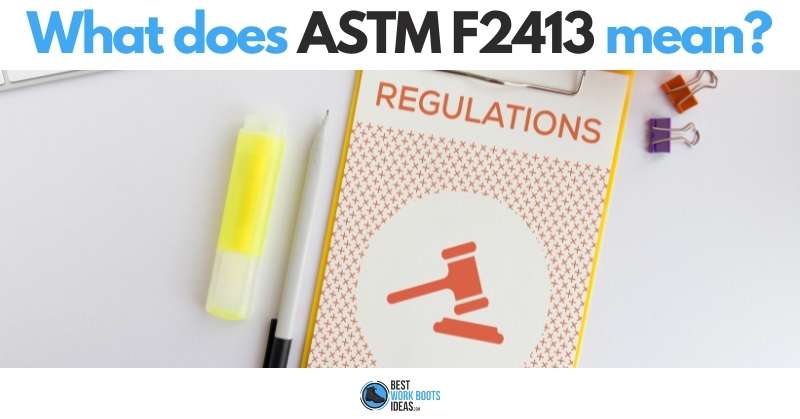
ASTM F2413 is a safety test done on work boots and protective footwear that rates them for safety features to protect against workplace hazards. The most common rating sought is a steel safety toe, however there is puncture resistance, electrical hazard resistance and many other ratings given in addition to OSHA-approved safety toes.
In this article I’ll cover everything you need to know about this particular safety guideline.
You’ll also learn how to use it to grab the perfect pair of boots for your next purchase.
If you’re looking for safety footwear symbols and what they mean then you should read that after you have read this article.
Contents
What is ASTM?
ASTM International is an non-profit organization that conducts tests on the strength and safety of materials used around the world.
From the strength of steel in buildings, to the toxicity of plastics in our childrens’ toys, ASTM tests the safety of boots among thousands of other products.
It used to be called “American Society for Testing and Materials.”
You’ll see ASTM being referenced quite a LOT in this site since it very relevant.
The ASTM and OSHA walk in step with one another.
Despite the fact that one is a government agency and the other an international non-profit, the two organizations have agreed on the ASTM’s test since 2005.
OSHA indicates that they determine if something is “safe” based on this test.
Obviously, that could change at some point in the future, but for now the two organizations are birds of a feather.
What Do I Need to Know About ASTM F2413?
ASTM F2413 is the name of a test that the OSHA and most American employers rely on to determine if footwear is okay to wear at work.
Within the test are a number of different categories, each indicated by a code.
Your employer probably wants you wearing I/C/75 boots, but they might want more as well, depending on the work you do.
If you don’t know what that means, keep reading, you will.
Below is a key to abbreviations used when discussing results of the F2413 test.
Get Good Test Results: Your Guide to the ASTM F2413 Code System
A boot can be rated in a number of categories.
Just because you see it’s F2413 rated doesn’t mean it possesses all possible safety features.
From most to least common, here are all the F2413 ratings, what they certify, and the code you’ll need to identify them in product descriptions.
I/75 – Impact/75 – Has a safety toe cap that can withstand an impact of a 75 pound object dropped from 18 inches of height while still leaving ½” clearance for men and 15/32” for women
C/75 – Compression/75 – Has a safety toe cap that can withstand 2,500 pounds of compression while still leaving ½” clearance for men and 15/32” for women
Mt/75 – Metatarsal/75 – Has metatarsal protection for the instep of the foot that can withstand a 75 pound object dropped from 18 inches of height while still leaving ½” clearance for men and 15/32” for women
SR – Slip-resistant outsoles as required by OSHA. Sometimes you will see this quietly listed with F2413 even though slip resistance is not part of the official test. The manufacturer of the outsoles certifies that the material is slip- and oil- resistant
PR – Has puncture-resistant soles that can prevent up to 270 pounds of force without visually penetrating the boot. This test doesn’t specify if it’s the outsole, midsole, insole, or footbed that is rated for puncture resistance, so check the manufacturer’s description on each product to find out where the protection is.
EH – Electrical Hazard – Boots able to withstand 18,000 volts at 60 hertz for one minute with less than one milliampere of current leakage (under dry conditions). This comes from specially designed outsoles and heels that gives the wearer better electrical grounding
Used by workers that are likely to encounter live electrical wires throughout their days.
SD – Static Dissipative – Boots that are designed to dissipate static electricity buildup through the ground. Used by workers for further electrical protection.
CD – Conductive Footwear – Actively conductive boots that are designed to pull any electrical currents away from the rest of the body and out through the feet. Used by workers in munitions, chemical, and oil industry work where a single spark could ignite a factory. Not suitable for everyday workers
CS – Chainsaw Resistant – Boots that have chainsaw resistant uppers like some logging boots
DI – Dielectric Insulation – The most electrically insulated boots, ideal for people working with downed power lines that have unpredictable currents.
What Do All the Numbers Stand For in ASTM F2413, F2413-11, F2413-18? What Does All That Mean?
It’s not confusing! Astm is the organization, F2413 is the name of the test, and the numbers seen at the end refers to the year of the test’s issue.
The test was made in 2005, updated in 2011 and 2018, so manufacturers will clarify which version of the test they passed.
| Testing Organization | Test number | Year of issue | Mens/Womens boots | Features |
| astm | F2413 | -11 | m | i/c/75 EH PR SR |
| astm | F2413 | -18 | f | i/c/75 Mt EH PR |
| astm | F2413 | -19 | m | i/c/75 Mt CS PR |
Sometimes you will see a different year of issue, that’s okay, that just indicates the year this test was conducted.
If I see boots that are markled astm F2413-21, I just know that the manufacturer tested the boots as recently as 2021.
What Does ASTM F2892 Mean?
Astm F2892 is a safety standard test conducted for soft toe work boots. It qualifies them for non-safety toe protective features.
What is the ANSI Z41 Standard?
The ANSI Z41 is an old safety footwear standard that was replaced after March 2005.
In its place came F2412 and F2413.
What is EN ISO 20345:2011?
Similar to the ASTM standard, the EN ISO 20345 is a European safety footwear standard that tests a work shoe adheres to specific safety requirements.
This is soon to be replaced by the ISO/FDIS 20345 standard.
That’s All on ASTM
Hopefully that’s given you a better insight on what’s the ASTM F2413 standard means?
Always remember to check that your personal protective equipment complies with the latest ASTM standards.
The last thing you want is a foot injury from non compliant footwear.
